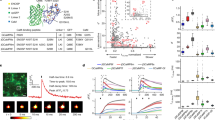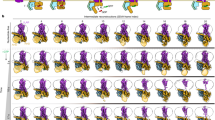Abstract
Phototransduction in invertebrate microvillar photoreceptors is thought to be mediated by the activation of phospholipase C (PLC), but how this leads to gating of the light-sensitive channels is unknown1,2. Most attention has focused on inositol-1,4,5-trisphosphate, a second messenger produced by PLC from phosphatidylinositol-4,5-bisphosphate; however, PLC also generates diacylglycerol, a potential precursor for several polyunsaturated fatty acids, such as arachidonic acid and linolenic acid. Here we show that both of these fatty acids reversibly activate native light-sensitive channels (transient receptor potential (TRP) and TRP-like (TRPL)) in Drosophila photoreceptors as well as recombinant TRPL channels expressed in Drosophila S2 cells. Recombinant channels are activated rapidly in both whole-cell recordings and inside-out patches, with a half-maximal effector concentration for linolenic acid of ∼10 µM. Four different lipoxygenase inhibitors, which might be expected to lead to build-up of endogenous fatty acids, also activate native TRP and TRPL channels in intact photoreceptors. As arachidonic acid may not be found in Drosophila, we suggest that another polyunsaturated fatty acid, such as linolenic acid, may be a messenger of excitation in Drosophila photoreceptors.
This is a preview of subscription content, access via your institution
Access options
Subscribe to this journal
Receive 51 print issues and online access
$199.00 per year
only $3.90 per issue
Buy this article
- Purchase on Springer Link
- Instant access to full article PDF
Prices may be subject to local taxes which are calculated during checkout




Similar content being viewed by others
References
Hardie, R. C. & Minke, B. Phosphoinositide-mediated phototransduction in Drosophila photoreceptors: the role of Ca2+ and trp. Cell Calcium 18, 256–274 (1995).
Ranganathan, R., Malicki, D. M. & Zuker, C. S. Signal transduction in Drosophila photoreceptors. Annu. Rev. Neurosci. 18, 283–317 (1995).
Berridge, M. J. Inositol trisphosphate and calcium signalling. Nature 361, 315–325 (1993).
Montell, C. & Rubin, G. M. Molecular characterization of Drosophila trp locus, a putative integral membrane protein required for phototransduction. Neuron 2, 1313–1323 (1989).
Phillips, A. M., Bull, A. & Kelly, L. E. Identification of a Drosophila gene encoding a calmodulin-binding protein with homology to the trp phototransduction gene. Neuron 8, 631–642 (1992).
Hardie, R. C. & Minke, B. The trp gene is essential for a light-activated Ca2+ channel in Drosophila photoreceptors. Neuron 8, 643–651 (1992).
Niemeyer, B. A., Suzuki, E., Scott, K., Jalink, K. & Zuker, C. S. The Drosophila light-activated conductance is composed of the two channels TRP and TRPL. Cell 85, 651–659 (1996).
Reuss, H., Mojet, M. H., Chyb, S. & Hardie, R. C. In vivo analysis of the Drosophila light-sensitive channels, TRP and TRPL. Neuron 19, 1249–1259 (1997).
Petersen, C. C. H., Berridge, M. J., Borgese, M. F. & Bennett, D. L. Putative capacitative calcium entry channels: expression of Drosophila trp and evidence for the existence of vertebrate homologues. Biochem. J. 311, 41–44 (1995).
Wes, P. D. et al. TRPC1, a human homolog of a Drosophila store-operated channel. Proc. Natl Acad. Sci. USA 92, 9652–9656 (1995).
Birnbaumer, L. et al. On the molecular basis and regulation of cellular capacitative calcium entry: roles for Trp proteins. Proc. Natl Acad. Sci. USA 93, 15195–15202 (1996).
Smith, D. P. et al. Photoreceptor deactivation and retinal degeneration mediated by a photoreceptor-specific protein-kinase-C. Science 254, 1478–1484 (1991).
Hardie, R. C. et al. Protein kinase C is required for light adaptation in Drosophila photoreceptors. Nature 363, 634–637 (1993).
Yoshioka, T. et al. Evidence that arachidonic acid is deficient in phosphatidylinositol of Drosophila heads. J. Biochem. 98, 657–662 (1986).
Stark, W. S., Lin, T. N., Brackhahn, D., Christianson, J. S. & Sun, G. Y. Fatty-acids in the lipids of Drosophila heads — effects of visual mutants, carotenoid deprivation and dietary fatty-acids. Lipids 28, 345–350 (1993).
Meves, H. Modulation of ion channels by arachidonic acid. Prog. Neurobiol. 43, 175–186 (1994).
Pearn, M. T., Randall, L. L., Shortridge, R. D., Burg, M. G. & Pak, W. L. Molecular, biochemical, and electrophysiological characterization of Drosophila norpA mutants. J. Biol. Chem. 271, 4937–4945 (1996).
Scott, K., Becker, A., Sun, Y., Hardy, R. & Zuker, C. G(q alpha) protein function in vivo: genetic dissection of its role in photoreceptor cell physiology. Neuron 15, 919–927 (1995).
Shim, K. et al. Control of Drosophila retinoid and fatty acid binding glycoprotein expression by retinoids and retinoic acid: northern, western and immunocytochemical analyses. Exp. Eye Res. 65, 717–727 (1997).
Hardie, R. C., Reuss, H., Lansdell, S. J. & Millar, N. S. Functional equivalence of native light-sensitive channels in the Drosophila trp301 mutant and TRPL cation channels expressed in a stably transfected Drosophila cell line. Cell Calcium 21, 431–440 (1997).
Karnovsky, M. J., Kleinfeld, A. M., Hoover, R. L. & Klausner, R. D. The concept of lipid domains in membranes. J. Cell Biol. 94, 1–6 (1982).
Anderson, M. P. & Welsh, M. J. Fatty acids inhibit apical membrane chloride channels in airway epithelia. Proc. Natl Acad. Sci. USA 87, 7334–7338 (1990).
Acharya, J. K., Jalink, K., Hardy, R. W., Hartenstein, V. & Zuker, C. S. InsP3receptor is essential for growth and differentiation but not for vision in Drosophila. Neuron 18, 881–887 (1997).
Dong, Y., Kunze, D. L., Vaca, L. & Schilling, W. P. Ins(1,4,5)P3activates Drosophila cation channel Trpl in recombinant baculovirus-infected Sf9 insect cells. Am. J. Physiol. Cell Physiol. 269, C1332–C1339 (1995).
Zimmer, S., Trost, C., Cavalie, A., Philipp, S. & Flockerzi, V. The trpl protein is a Ca2+-calmodulin activated non-selective cation (CAN) channel. Naunyn-Schmiedebergs Arch. Pharmacol. 355, 238 (1997).
Obukhov, A. G. et al. Direct activation of trpl cation channels by G alpha11 subunits. EMBO J. 15, 5833–5838 (1996).
Van der Zee, L., Nelemans, A. & Den Hertog, A. Arachidonic acid is functioning as a second messenger in activating the Ca2+ entry process on H1-histaminoceptor stimulation in DDT1 MF-2 cells. Biochem. J. 305, 859–864 (1995).
Shuttleworth, T. J. Arachidonic-acid activates the noncapacitative entry of Ca2+ during [Ca2+]ioscillations. J. Biol. Chem. 271, 21720–21725 (1996).
Hardie, R. C. Whole-cell recordings of the light-induced current in Drosophila photoreceptors: evidence for feedback by calcium permeating the light sensitive channels. Proc. R. Soc. Lond. B 245, 203–210 (1991).
Hardie, R. C. INDO-1 measurements of absolute resting and light-induced Ca2+ concentration in Drosophila photoreceptors. J. Neurosci. 16, 2924–2933 (1996).
Acknowledgements
We thank C. Taylor and Z. Selinger for discussions, and L. Kelly and W. A. Harris for discussions and comments on an earlier version of this paper. The work was supported by the Wellcome Trust and the BBSRC.
Author information
Authors and Affiliations
Corresponding author
Rights and permissions
About this article
Cite this article
Chyb, S., Raghu, P. & Hardie, R. Polyunsaturated fatty acids activate the Drosophila light-sensitive channels TRP and TRPL. Nature 397, 255–259 (1999). https://doi.org/10.1038/16703
Received:
Accepted:
Issue Date:
DOI: https://doi.org/10.1038/16703
This article is cited by
-
Functional expression of Δ12 fatty acid desaturase modulates thermoregulatory behaviour in Drosophila
Scientific Reports (2020)
-
Residual vitellus and energetic state of wolf spiderlings Pardosa saltans after emergence from egg-sac until first predation
Journal of Comparative Physiology B (2020)
-
Molecular basis for the sensitivity of TRP channels to polyunsaturated fatty acids
Naunyn-Schmiedeberg's Archives of Pharmacology (2018)
-
The TRPM1 channel in ON-bipolar cells is gated by both the α and the βγ subunits of the G-protein Go
Scientific Reports (2016)
-
Ocular transient receptor potential channel function in health and disease
BMC Ophthalmology (2015)
Comments
By submitting a comment you agree to abide by our Terms and Community Guidelines. If you find something abusive or that does not comply with our terms or guidelines please flag it as inappropriate.



